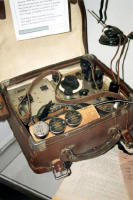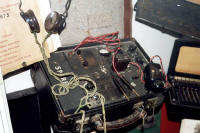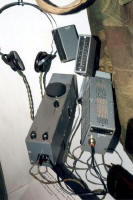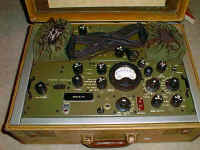|
As World War II, (WWII) began, the United States found itself quite unprepared in almost every aspect of military operations. Intelligence was no exception. Years of isolationism and the"Gentlemen Don't Read others Mail" mentality resulted in a lack of experience, equipment and doctrine, especially in the field of strategic intelligence. Within the military, all the General Staff positions were headed by Generals except intelligence which was headed by a Colonel. As a result, both our policy makers and military were dependent on information supplied by the British and other Allies.
America's first attempt at a centralised intelligence effort was the establishment of the office of the Co-ordination of Information under General William B. Donovan. In announcing this position, President Roosevelt spelled out what it was NOT but no what is was!!! The C.O.I. eventually gave way to the Office of Strategic Services, O.S.S. for short. Amiong the many tasks assigned to the OSS was the control of agents operating behind enemy lines. These agents needed reliable means of communication to their operational bases. Special radios were needed.
The British began the war with the Mark XV set. Housed in two wooden cases, it covered 3.5 MC to 16 MC. The transmitter used the newly developed U.S. metal tubes, using the 6F6 as an oscillator and the 6L6 as a power amplifier. The transmitter had an output of 15 - 20 watts but the receiver was a regenerative set.
The Mark XV set was followed by the Para set, housed in a small stainless steel case and using three tubes, a 6V6 in the transmitter and two 6SK7's in the receiver. Shortly after the outbreak of war, Prime Minister Churchill created the Special Operations Executive, S.O.E. for short. Charged with the mission of "setting Europe on fire", the SOE began to develop special radios. By August 1942, the first of these sets appeared and was designated Mark 21 set which was not very good. This was quickly followed by the A Mark II transceiver which used the newly developed Loctal tubes. This set covered 3 - 9 MC and the first production sets were delivered in October 1942.
This set was followed by the Type 3 MK II B 2 set which became the main set in use from 1943 to 1945 and beyond. This set covered from 3 - 15.5 MC, and used EL32 and 6L6 tubes in the transmitter which provided a power output of 30 watts. The companion receiver was a four tube heterodyne set, which along with a power supply, accessories case and transmitter fitted neatly into a small suitcase, hence the name suitcase radio. The set was also issued in two metal containers but the most commonly found sets were in suitcases.
The last set to be developed during the war was the A MK III suitcase transceiver, a much more compact set than the "B2" set. This set was completely miniaturised except for the use of U.S. loctal tubes. This set covered 3.2 - 9 MC, had a two tube transmitter of 5 watts power and a four tube superhetrodyne receiver. The set weighted about 5 1/2 lbs. The general trend of British sets was toward smaller and lighter as well as lower power sets.
In addition to the SIS and SOE sets, a whole series of radios was developed by Polish immigrants, working near Bletchly Park, site of Station X, where decoding of intercepted messages was accomplished. The best know of these sets were the BP 3 and AP 4 sets but there were many others. These sets were used primarily by the British S.I.S. Highly compact and fully miniaturised, these sets today are also highly prized collectors items. For further information on these sets, the book by Pierre Lorain and Keith Melto are excellent references.
The United States relied heavily on the British sets but did produce several of their own clandestine sets. The Military Intelligence Service was responsible for the development of the AN/TRC 10 and the AN/PRC 5 radios. The TRC 10 was developed for the rescue of downed pilots. Total production is supposed to have been 155 sets and only three are still known to be in existence. There was some speculation the the CIA used these sets in Angola during the 1970's but this is unconfirmed. The OSS was responsible for the development of two clandestine sets that were designed specifically for use by agents.
The first of these was the SSTR 1 set which consisted of the transmitter, receiver and power supply mounted in a suitcase, but each unit was small enough to have been concealed in something else. In designing a radio for clandestine service, a different set of criteria was required. Small size, conceivability, lightweight and low power were more important than range and selectivity. These sets also required a power supply that could be used almost anywhere in the world. AC systems ranged from 90VAC to 235 VAC, which meant some sort of switching for the power input. As a result the power supply became the critical factor in radio design. Most of the power supplies of the period consisted of a heave power transformer, a rectifier and a filter system. The weight of the power transformer then became the crucial factor and determined the weight of the over-all set.
 Para Set |
|
 SOE A Mk 3 |
|
 Biscuit Receiver |
Receivers were also important but their ability to pick up signals was more a function of the transmitter output than the selectivity of the receiver. A more powerful base station transmitter could be used as size and weight were not a consideration. The important criteria, then for the clandestine set, was the output of the transmitter. In the European theatre, agents were at most 100 miles from an operating base station.
Usually in England or perhaps North Africa or Italy. However, in the Pacific Theatre the agent might be a thousand or more miles from a base station. Such was the case with the Coast Watchers, scattered on various islands. They used a set described a portable but that 16 porters were required to carry all the equipment!!!
To meet the criteria for use in Europe, the SSTR 1 set had a one tube transmitter with an output of 8-15 watts and a range of 300 to 1000 miles. The transmitter covered 3.0 - 14.0 MC in three bands and was capable of only CW transmission. The companion receiver was a five tube superhetrodyne set capable of receiving voice, tone and CW with a frequency range of 2.7 - 17 MC in two bands.
In addition to the main power supply, this set could be powered by batteries, a hand cranked generator, and wood burning thermocouples. Again, power supplies were as varied as the conditions of their use. There was even a windmill power supply that was used to re-charge storage batteries.
The transmitter was 4" x 3" x 9 1/2", the receiver was also the same size and the power supply was 6" x 3 1/2" x 9 1/2" depending on which power supply was used. The complete set had a weight of between 20 to 44 lbs, again depending on which power supply was used. The transmitter was based on a 6L6 tube. The crystal socket was a multi-holed socket and would accept several variations of crystals. The tank coil was actually three separate coils, one covering 3 - 5 MC, one covering 5 - 8 MC and the last covering 8 - 14 MC. Transmitter output was fed to a series of resistors and a lamp for tuning or directly to the antenna in the operate position. In recent years several of these transmitters have turned up but the receivers are hard to find and I am told the power supplies are impossible to find. Like others, I too am looking for the receiver and power supply.
As is always the case with military equipment, as soon as one item is fielded, it's replacement is already off the drawing board and about to enter production. The replacement for the SSTR-1 would become known as the SSTR-5. As of this writing there are only three of these complete sets known to exist. In attempting to track down the developmental history of this set, I got nothing. The Signal Corps, the CIA, the NSA and the National Archives could supply no information on these sets. The only fact that seems to be definite is that they were made by the Philharmonic Radio Company.
The general consensus of opinion is that while these sets were about to enter production, the war ended and so did the need for the set. The receivers, however were built and issued to the field and saw considerable use in China and other parts of the Pacific. It is assumed that a contract was let for so many thousand of these sets and production was begun. When the war ended and the contract was cancelled, there must have been several hundred sets that were not assembled. One of the popular electronic magazine of the period had ad's for a kit radio, billed as the famous "LUCY RADIO" and sold for $19.95. It had all the parts needed to assemble an SSR 5A receiver and I suspect that many of the SSR 5A receivers that can be found today started as LUCY kits!!!
The controls consist of an OPERATE / TUNE switch which puts a series of resistors and a lamp into the antenna circuit for tuning. Tuning is accomplished by two controls, a tuning control which is a variable capacitor and a tap switch connected to taps on the tank coil. Two neon lamps monitor the oscillator and the condition of the batteries. In addition to these controls, a key is mounted on the chassis and a power connection socket is provided for the power cord from the receiver. Three binding posts provide connections for the main antenna and connections to the receiver antenna and ground. The final control, mounted in the centre of the chassis, is a three position rotary switch which switches power and antenna / ground connections from the transmitter to the receiver. Two power cords come out from the base of the set an connect to two BA 48 dry cell batteries, which provide 1,5 volts for the filaments and 90 volts plate supply. The receiver uses on battery and in the transmit position both batteries are in series to provide 180 volts plate supply.
Visitors to this page since 28 August 1999 Last updated 02 January 2003
Back to Your Articles Index Page.
Army Radio Sales Co. Home Page.




